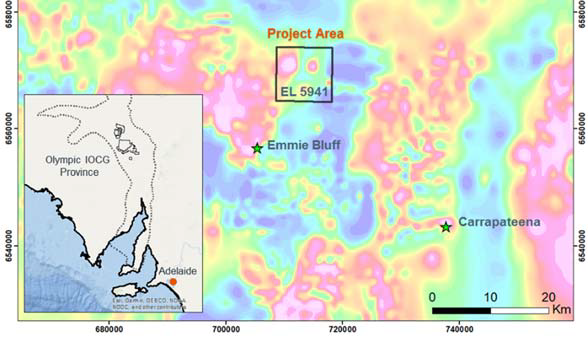BHP has confirmed identification of a potential new iron oxide, copper, gold (IOCG) mineralised system, located 65 km to the southeast of BHP’s operations at Olympic Dam in South Australia. As part of its ongoing copper exploration program, four diamond drill holes, totalling 5,346 m, intersected copper, gold, uranium and silver mineralisation of IOCG style on BHP’s exploration licence 5941.
Laboratory assay results show downhole mineralisation intercepts ranging from 0.5% to 6% Cu with associated gold, uranium and silver metals. This exploration project is at an early stage and there is currently insufficient geological information to assess the size, quality and continuity of the mineralised intersections. BHP is evaluating and interpreting the results reported and planning a further drilling program, to commence in early 2019.
BHP’s copper exploration program has targeted the Stuart Shelf in South Australia as part of a focused global program which includes Ecuador, Canada, Peru, Chile and the southwest of the USA.
Copper and oil are the main focus of BHP’s exploration programs in order to replenish its resource base and enhance its portfolio.
The project is located within the Exploration Licence 5941, 65 km southeast from BHP’s Olympic Dam and 45 km northeast from Carrapateena, in South Australia. The project has a long exploration history with initial exploratory drilling completed by Western Mining Corp in 1976 and several subsequent drilling campaigns since. Historic drilling has, however, been focused on the easternmost geophysical anomaly in the project area, with only three drill holes drilled to test the larger western anomaly between 1983 and 1985.
Recent target definition completed in 2018 included re-interpretation of historic drill hole geology, geochemistry and geophysics of the prospect and collection of new high resolution gravity. The re-assessment was followed by four drill holes to further test the geophysical anomal.
The project has a similar regional setting as the Olympic Dam deposit and is located in the eastern margin of the Gawler Craton, within the Olympic IOCG metallogenic province. It is overlain by between 700 and 950 m of post mineral, consolidated, sedimentary rocks of meso-
Proterozoic age and younger. Pre-mineral basement in AD4 comprises iron rich hematite breccias and sedimentary rocks and is barren of mineralisation (max Cu 0.03%). AD7 to the east intersected iron rich conglomerates and breccias at the expected base of post mineral cover in fault contact with moderately brecciated and sericite altered granite and is also barren of mineralisation (max Cu 0.01%). AD13 to the northwest ended at 852m in post mineral cover. Accurate down hole survey information for historic drilling is unavailable and drill holes are assumed to be vertical.
Recent drilling in 2018 has intersected IOCG-style alteration and mineralisation. The main Cu sulphide species are chalcocite, bornite and chalcopyrite. Copper sulphides occur primarily as disseminated accumulations and are associated with iron oxide rich breccias. AD22 and 24 to the south have intersected iron oxide and siderite altered, brecciated granites and chalcopyrite dominant mineralisation. AD23 and 25 in the north have intersected: pervasively altered iron oxide rich breccias and fine grained sedimentary clastic rocks, generally barren of copper mineralisation; massive hematite breccias with high grade chalcocite-bornite mineralisation; and both holes end in moderate to weakly hematite altered, brecciated granites dominated by chalcopyrite mineralisation in AD23 and pyrite mineralisation in AD25.
BHPs copper exploration team is currently evaluating and interpreting the results reported here and planning suitable follow up drilling.











